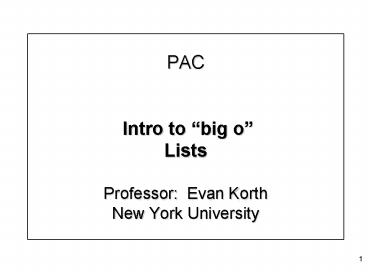PAC Intro to - PowerPoint PPT Presentation
1 / 14
Title:
PAC Intro to
Description:
PAC Intro to big o Lists Professor: Evan Korth New York University * Road Map for Today A cursory introduction to Big Oh Abstract Data Types Lists Array ... – PowerPoint PPT presentation
Number of Views:96
Avg rating:3.0/5.0
Title: PAC Intro to
1
PAC Intro to big oLists Professor Evan
KorthNew York University
1
2
Road Map for Today
- A cursory introduction to Big Oh
- Abstract Data Types
- Lists
- Array implementation
- Linked Lists
2
3
Abstract Data Type
- An abstract data type (ADT) is a set of objects
together with a set of operations. For example - Stacks
- Queues
- Dictionary
- Trees
- Priority queue
3
4
Analyzing Data Structures
- In order to discuss what makes a good data
structure, we need a way to analyze the execution
behavior of a data structure. - Two of the most important considerations we need
to keep in mind are - Time complexity
- Space complexity
- There are other important considerations such as
code complexity but we will concentrate on time
and space for now.
5
Time Complexity
- How long will the program take
- For each of the data structure's operations we
want to know how many instructions must be
executed. - We don't need to know the exact number of
instructions because that depends on the compiler
and instruction set of our environment. - In other words, we want this system to be machine
and compiler independent. - For small sets of data, it does not matter much.
- We need a theoretical system to quantify how the
execution time grows as our data size grows.
6
Time Complexity
- For each of the data structure's operations we
want to know how many instructions must be
executed. - Perhaps we can determine a program will execute a
maximum of 4n3 4n2 87n 15 instructions on
a pc for a dataset of size n. - Do we need to be so precise if we are only
concerned with the growth rate of our programs
execution time?
7
Asymptotic analysis
- Asymptotic analysis is based on the idea that as
the problem size grows, the complexity can be
described as a simple proportionality to some
known function. This idea is incorporated in the
"Big Oh" notation for asymptotic performance. - Definition T(n) O(f(n)) if and only if there
are constants c0 and n0 such that T(n) lt c0 f(n)
for all n gt n0. - The expression "T(n) O(f(n))" is read as "T of
n is in Big Oh of f of n." Big Oh is sometimes
said to describe an "upper-bound" on the
complexity. Other forms of asymptotic analysis
("Big Omega", "Little Oh", "Theta") are similar
in spirit to Big Oh, but will not be discussed in
this class.
Thomas A. Anastasio, Richard Chang
8
Big O What does it mean in English?
- Big O defines the upper bound of the running time
of an operation or algorithm without regard to
constants or machine / compiler factors. - We just throw away leading constants and low
order terms.
9
Some common functions which describe growth rates
(in order)
- O(1) constant
- O(log n) logarithmic
- O(n) linear
- O(n log n) linearithmic
- O(n2) quadratic
- O(n3) cubic
- O(2n) exponential
10
One quick example
- Linear search versus binary search
- See this applet
- http//www.cosc.canterbury.ac.nz/people/mukundan/d
sal/appldsal.html - What is the big oh for linear search?
- What is the big oh for binary search?
- We will discuss the time complexity for the
operations of every ADT and algorithm we look at
in this class.
11
List
- List (data structure)
- Definition A collection of items accessible one
after another beginning at the head and ending at
the tail. - Head The first item in a list
- Tail The last item in a list
Source http//www.nist.gov/dads/HTML/list.html
12
List operations (one possible example)
- printList
- makeEmpty
- find
- findKth
- insert
- remove
- isEmpty
- first
- findPrevious
13
First idea Use an array
- Need to estimate size for the array from the
beginning. If we need to expand the array it is
expensive (in Java) or impossible (in some other
languages). This wastes considerable space. - Also insertions and deletions are expensive
because we may need to move elements in order to
execute the operation (on average half are moved
worse case all must be moved).
14
Better idea linked list
- Basic idea is to create a node for each element.
The node will contain the element as well as a
pointer to the next node. - We need to keep track of the head and the tail
somehow. - This change means when we insert and delete
nodes, all we need to do is move the pointers
around.































